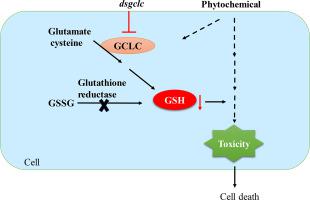当前位置:
X-MOL 学术
›
Pestic. Biochem. Phys.
›
论文详情
Our official English website, www.x-mol.net, welcomes your
feedback! (Note: you will need to create a separate account there.)
Inhibition of the glutathione biosynthetic pathway increases phytochemical toxicity to Spodoptera litura and Nilaparvata lugens
Pesticide Biochemistry and Physiology ( IF 4.2 ) Pub Date : 2020-09-01 , DOI: 10.1016/j.pestbp.2020.104632 Yongjie Cen 1 , Xiaopeng Zou 1 , Lanbin Li 1 , Shuna Chen 1 , Yiguang Lin 1 , Lin Liu 1 , Sichun Zheng 1
Pesticide Biochemistry and Physiology ( IF 4.2 ) Pub Date : 2020-09-01 , DOI: 10.1016/j.pestbp.2020.104632 Yongjie Cen 1 , Xiaopeng Zou 1 , Lanbin Li 1 , Shuna Chen 1 , Yiguang Lin 1 , Lin Liu 1 , Sichun Zheng 1
Affiliation

|
Phytochemicals are toxic to insects, but their insecticidal efficiencies are usually low compared to synthetic insecticides. Understanding the mechanism of insect adaptation to phytochemicals will provide guidance for increasing their efficacy. Reduced glutathione (GSH) is a scavenger of reactive oxygen species (ROS) induced by phytochemicals. However, in insects, the pathway of GSH biosynthesis in response to phytochemicals is unclear. We found that exposure to 0.5% indole-3-methanol (I3C), xanthotoxin, and rotenone (ROT) significantly retarded the growth of Spodoptera litura larvae. The oxidative stress in S. litura larvae exposed to phytochemicals was increased. The up-regulation of glutamate cysteine ligase but not glutathione reductase revealed that the de novo synthesis pathway is responsible for GSH synthesis in phytochemical-treated larvae. Treatment with the inhibitor (BSO) of γ-glutamylcysteine synthetase (gclc), a subunit of glutamate cysteine ligase, resulted in decreases of GSH levels and GST activities, increases of ROS levels in I3C-treated larvae, which finally caused midgut necrosis and larval death. Treatment with BSO or I3C alone did not cause larval death. The addition of GSH could partly reduce the influence of I3C and BSO on S. litura growth. Nilaparvata lugens gclc RNAi confirmed the result of BSO treatment in S. litura. N. lugens gclc RNAi significantly increased the mortality of ROT-sprayed N. lugens, in which ROS levels were significantly increased. All data indicate that gclc is involved in insect response to phytochemical treatment. Treatment with dsgclc will increase the insecticidal efficacy of plant-derived compounds.
中文翻译:

谷胱甘肽生物合成途径的抑制会增加对斜纹夜蛾和褐飞虱的植物化学毒性
植物化学物质对昆虫有毒,但与合成杀虫剂相比,它们的杀虫效率通常较低。了解昆虫对植物化学物质的适应机制将为提高其功效提供指导。还原型谷胱甘肽 (GSH) 是植物化学物质诱导的活性氧 (ROS) 清除剂。然而,在昆虫中,响应植物化学物质的 GSH 生物合成途径尚不清楚。我们发现暴露于 0.5% 吲哚-3-甲醇 (I3C)、黄酮和鱼藤酮 (ROT) 会显着延缓斜纹夜蛾幼虫的生长。暴露于植物化学物质的斜纹夜蛾幼虫的氧化应激增加。谷氨酸半胱氨酸连接酶而不是谷胱甘肽还原酶的上调表明从头合成途径是植物化学处理的幼虫中谷胱甘肽合成的原因。用谷氨酸半胱氨酸连接酶亚基 γ-谷氨酰半胱氨酸合成酶 (gclc) 的抑制剂 (BSO) 处理导致 GSH 水平和 GST 活性降低,I3C 处理的幼虫中 ROS 水平增加,最终导致中肠坏死和幼虫死亡。单独用 BSO 或 I3C 治疗不会导致幼虫死亡。添加 GSH 可以部分降低 I3C 和 BSO 对斜纹夜蛾生长的影响。Nilaparvata lugens gclc RNAi 证实了斜纹夜蛾 BSO 处理的结果。N. lugens gclc RNAi 显着增加了 ROT 喷洒的 N. lugens 的死亡率,其中 ROS 水平显着增加。所有数据表明 gclc 参与昆虫对植物化学处理的反应。用 dsgclc 处理将增加植物衍生化合物的杀虫功效。
更新日期:2020-09-01
中文翻译:

谷胱甘肽生物合成途径的抑制会增加对斜纹夜蛾和褐飞虱的植物化学毒性
植物化学物质对昆虫有毒,但与合成杀虫剂相比,它们的杀虫效率通常较低。了解昆虫对植物化学物质的适应机制将为提高其功效提供指导。还原型谷胱甘肽 (GSH) 是植物化学物质诱导的活性氧 (ROS) 清除剂。然而,在昆虫中,响应植物化学物质的 GSH 生物合成途径尚不清楚。我们发现暴露于 0.5% 吲哚-3-甲醇 (I3C)、黄酮和鱼藤酮 (ROT) 会显着延缓斜纹夜蛾幼虫的生长。暴露于植物化学物质的斜纹夜蛾幼虫的氧化应激增加。谷氨酸半胱氨酸连接酶而不是谷胱甘肽还原酶的上调表明从头合成途径是植物化学处理的幼虫中谷胱甘肽合成的原因。用谷氨酸半胱氨酸连接酶亚基 γ-谷氨酰半胱氨酸合成酶 (gclc) 的抑制剂 (BSO) 处理导致 GSH 水平和 GST 活性降低,I3C 处理的幼虫中 ROS 水平增加,最终导致中肠坏死和幼虫死亡。单独用 BSO 或 I3C 治疗不会导致幼虫死亡。添加 GSH 可以部分降低 I3C 和 BSO 对斜纹夜蛾生长的影响。Nilaparvata lugens gclc RNAi 证实了斜纹夜蛾 BSO 处理的结果。N. lugens gclc RNAi 显着增加了 ROT 喷洒的 N. lugens 的死亡率,其中 ROS 水平显着增加。所有数据表明 gclc 参与昆虫对植物化学处理的反应。用 dsgclc 处理将增加植物衍生化合物的杀虫功效。









































 京公网安备 11010802027423号
京公网安备 11010802027423号